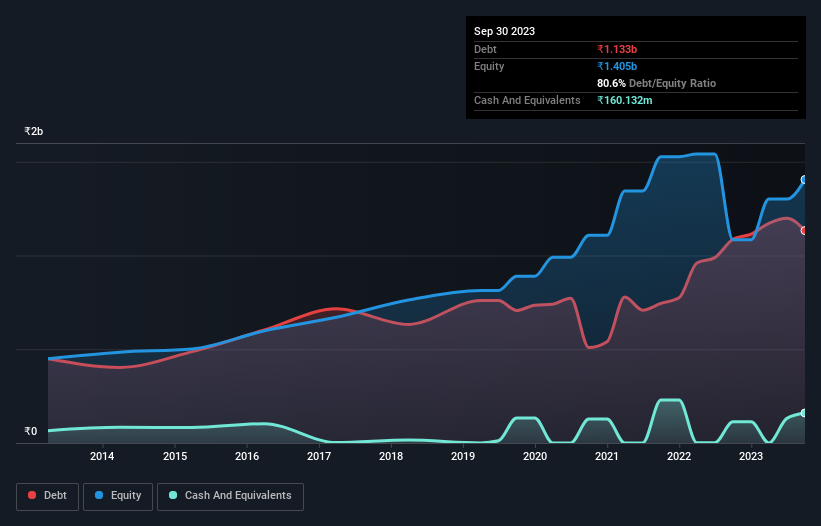Here's Why Kriti Industries (India) (NSE:KRITI) Has A Meaningful Debt Burden

Howard Marks put it nicely when he said that, rather than worrying about share price volatility, 'The possibility of permanent loss is the risk I worry about... and every practical investor I know worries about.' So it seems the smart money knows that debt - which is usually involved in bankruptcies - is a very important factor, when you assess how risky a company is. As with many other companies Kriti Industries (India) Limited (NSE:KRITI) makes use of debt. But is this debt a concern to shareholders?
When Is Debt A Problem?
Debt assists a business until the business has trouble paying it off, either with new capital or with free cash flow. If things get really bad, the lenders can take control of the business. However, a more usual (but still expensive) situation is where a company must dilute shareholders at a cheap share price simply to get debt under control. Of course, debt can be an important tool in businesses, particularly capital heavy businesses. The first step when considering a company's debt levels is to consider its cash and debt together.
See our latest analysis for Kriti Industries (India)
How Much Debt Does Kriti Industries (India) Carry?
The image below, which you can click on for greater detail, shows that at September 2023 Kriti Industries (India) had debt of ₹1.13b, up from ₹1.09b in one year. However, because it has a cash reserve of ₹160.1m, its net debt is less, at about ₹972.8m.

A Look At Kriti Industries (India)'s Liabilities
We can see from the most recent balance sheet that Kriti Industries (India) had liabilities of ₹2.40b falling due within a year, and liabilities of ₹403.9m due beyond that. Offsetting this, it had ₹160.1m in cash and ₹509.9m in receivables that were due within 12 months. So its liabilities total ₹2.13b more than the combination of its cash and short-term receivables.
While this might seem like a lot, it is not so bad since Kriti Industries (India) has a market capitalization of ₹6.46b, and so it could probably strengthen its balance sheet by raising capital if it needed to. However, it is still worthwhile taking a close look at its ability to pay off debt.
We measure a company's debt load relative to its earnings power by looking at its net debt divided by its earnings before interest, tax, depreciation, and amortization (EBITDA) and by calculating how easily its earnings before interest and tax (EBIT) cover its interest expense (interest cover). The advantage of this approach is that we take into account both the absolute quantum of debt (with net debt to EBITDA) and the actual interest expenses associated with that debt (with its interest cover ratio).
Kriti Industries (India)'s net debt is sitting at a very reasonable 1.8 times its EBITDA, while its EBIT covered its interest expense just 3.1 times last year. While that doesn't worry us too much, it does suggest the interest payments are somewhat of a burden. We also note that Kriti Industries (India) improved its EBIT from a last year's loss to a positive ₹433m. The balance sheet is clearly the area to focus on when you are analysing debt. But it is Kriti Industries (India)'s earnings that will influence how the balance sheet holds up in the future. So if you're keen to discover more about its earnings, it might be worth checking out this graph of its long term earnings trend.
Finally, while the tax-man may adore accounting profits, lenders only accept cold hard cash. So it's worth checking how much of the earnings before interest and tax (EBIT) is backed by free cash flow. Looking at the most recent year, Kriti Industries (India) recorded free cash flow of 46% of its EBIT, which is weaker than we'd expect. That's not great, when it comes to paying down debt.
Our View
Kriti Industries (India)'s struggle to cover its interest expense with its EBIT had us second guessing its balance sheet strength, but the other data-points we considered were relatively redeeming. For example, its net debt to EBITDA is relatively strong. We think that Kriti Industries (India)'s debt does make it a bit risky, after considering the aforementioned data points together. That's not necessarily a bad thing, since leverage can boost returns on equity, but it is something to be aware of. The balance sheet is clearly the area to focus on when you are analysing debt. But ultimately, every company can contain risks that exist outside of the balance sheet. For example, we've discovered 3 warning signs for Kriti Industries (India) (1 is potentially serious!) that you should be aware of before investing here.
If, after all that, you're more interested in a fast growing company with a rock-solid balance sheet, then check out our list of net cash growth stocks without delay.
Valuation is complex, but we're here to simplify it.
Discover if Kriti Industries (India) might be undervalued or overvalued with our detailed analysis, featuring fair value estimates, potential risks, dividends, insider trades, and its financial condition.
Access Free AnalysisHave feedback on this article? Concerned about the content? Get in touch with us directly. Alternatively, email editorial-team (at) simplywallst.com.
This article by Simply Wall St is general in nature. We provide commentary based on historical data and analyst forecasts only using an unbiased methodology and our articles are not intended to be financial advice. It does not constitute a recommendation to buy or sell any stock, and does not take account of your objectives, or your financial situation. We aim to bring you long-term focused analysis driven by fundamental data. Note that our analysis may not factor in the latest price-sensitive company announcements or qualitative material. Simply Wall St has no position in any stocks mentioned.
About NSEI:KRITI
Kriti Industries (India)
Manufactures and sells plastic products and pipes in India and internationally.
Excellent balance sheet second-rate dividend payer.
Similar Companies
Market Insights
Community Narratives




